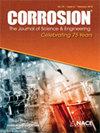Effect of Anodic Polarization on the Susceptibility of AA6111 Automotive Sheet to Stress Corrosion Cracking
IF 1.3
4区 材料科学
Q4 MATERIALS SCIENCE, MULTIDISCIPLINARY
引用次数: 0
Abstract
AA6xxx Al-Mg-Si-Cu alloys are increasingly used to meet lightweight objectives in automotive applications given their high strength-to-weight ratio. However, their use in conjunction with steels and carbon fiber-reinforced polymers in these applications will result in galvanic coupling that may be deleterious to the Al alloy. As such, the ability of anodic polarization to induce stress corrosion cracking (SCC) in AA6xxx, an alloy typically considered SCC-resistant, is explored. In this study, fracture mechanics-based testing under full immersion in 0.6 M NaCl was used to quantify the threshold stress intensity above which SCC can occur (KTH) and stage II SCC crack growth rate (da/dtII) as a function of applied potential at and above the freely corroding potential. Under freely corroding conditions and potentials applied within the range observed for the freely corroding potential, no SCC was observed as results matched those gathered in the air (i.e., KTH was equivalent to the measured fracture toughness). When applying potentials anodic to the freely corroding potential (greater than −706 mVSCE), a decrease in KTH and an increase in da/dtII was observed. Crack growth rates measured under anodic polarizations were slowed through the reapplication of the freely corroding potential. These data imply that galvanic coupling may have the capacity to induce severe SCC in AA6111.阳极极化对AA6111汽车板材应力腐蚀开裂敏感性的影响
由于具有高强度重量比,AA6xxx Al-Mg-Si-Cu合金越来越多地用于满足汽车应用的轻量化目标。然而,在这些应用中,它们与钢和碳纤维增强聚合物结合使用将导致可能对铝合金有害的电偶联。因此,阳极极化诱导应力腐蚀开裂(SCC)的能力在AA6xxx(一种通常被认为是抗SCC的合金)中进行了探索。在本研究中,采用了基于断裂力学的测试方法,在0.6 M NaCl中进行全浸,量化了超过SCC可能发生的阈值应力强度(KTH)和II期SCC裂纹扩展速率(da/dtII)作为自由腐蚀电位及以上的施加电位的函数。在自由腐蚀条件下,在观察到的自由腐蚀电位范围内,没有观察到SCC,因为结果与空气中收集的结果相匹配(即KTH相当于测量的断裂韧性)。当对自由腐蚀电位(大于- 706 mVSCE)施加阳极电位时,观察到KTH下降和da/dtII增加。通过重新应用自由腐蚀电位,在阳极极化下测量的裂纹扩展速率减慢。这些数据表明,电偶联可能有能力在AA6111中诱导严重的SCC。
本文章由计算机程序翻译,如有差异,请以英文原文为准。
求助全文
约1分钟内获得全文
求助全文
来源期刊

Corrosion
MATERIALS SCIENCE, MULTIDISCIPLINARY-METALLURGY & METALLURGICAL ENGINEERING
CiteScore
2.80
自引率
12.50%
发文量
97
审稿时长
3 months
期刊介绍:
CORROSION is the premier research journal featuring peer-reviewed technical articles from the world’s top researchers and provides a permanent record of progress in the science and technology of corrosion prevention and control. The scope of the journal includes the latest developments in areas of corrosion metallurgy, mechanisms, predictors, cracking (sulfide stress, stress corrosion, hydrogen-induced), passivation, and CO2 corrosion.
70+ years and over 7,100 peer-reviewed articles with advances in corrosion science and engineering have been published in CORROSION. The journal publishes seven article types – original articles, invited critical reviews, technical notes, corrosion communications fast-tracked for rapid publication, special research topic issues, research letters of yearly annual conference student poster sessions, and scientific investigations of field corrosion processes. CORROSION, the Journal of Science and Engineering, serves as an important communication platform for academics, researchers, technical libraries, and universities.
Articles considered for CORROSION should have significant permanent value and should accomplish at least one of the following objectives:
• Contribute awareness of corrosion phenomena,
• Advance understanding of fundamental process, and/or
• Further the knowledge of techniques and practices used to reduce corrosion.
 求助内容:
求助内容: 应助结果提醒方式:
应助结果提醒方式:


